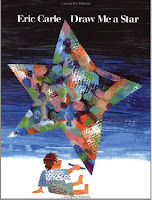
Draw Me A Star - Eric Carle
Summary:
This is a creative story in which a young artist starts by creating a star. The star then asks the artist for a sun. The journey continues as his newest creation asks the artist for another type of creation. The aging artist eventually ends up back at a star shape.
Thoughts of a Book Worm:
This is a simple story that is filled with Eric Carle's vibrant collages. Each artist creation desires something that can be connected to it. Just as in life, all of creation is connected in some way.
Reviews:
"Draw me a star. And the artist drew a star. It was a good star". So begins another of Carle's deceptively simple picture books. The star asks the artist to draw her a sun. Then the warm sun asks the artist to draw a tree and the tree puts in a request for some people. The people need a house which needs a dog and so on until the artist is asked by the moon to draw her a star and the cycle is almost complete. The artist starts out as a toddler drawing the star, and matures through the book. This unique version of the creation story can be interpreted on many levels. Carle's painted tissue paper collages are, as always, brilliant." - Children's Literature
"During his youth, this gifted authorartist explains in his newest book's afterword, his German grandmother would often draw him a star while chanting a nonsense rhyme. Taking that symbol as his foundation, Carle here creates a world pulsating with life and color-a world that bursts forth from a good star sketched by a young artist. This kaleidoseopic pentagram requests a sun from the artist's pen; the sun asks for a tree, and so on until a man and woman are living happily among Carle's characteristic collages-flora and fauna of all shapes, sizes and vivid hues. Meanwhile the artist, now a bearded old man, continues to draw and create. This unusual, practically plotless work seems to embody a personal scenario close to the artist's heart. His unadorned language, pulsing with a hypnotic rhythm, adroitly complements the familiar naive artwork. Though some may be disturbed by similarities between Carle's evolving world and the biblical creation story (the unclothed male and female figures, for example), this tale of imagination and creativity pays homage to the artist within all of us-and may well fire youngsters' imaginations. Ages 4-up." - Publisher's Weekly
Suggested Activities:
This book would be an excellent resource to use to have children think about and discuss how things are connected. Dogs chase cats, cats chase birds, birds chase butterflies, butterflies look for beautiful flowers, flowers hope for rainclouds, and the list goes on.
Eric Carle books are also a great example of collage style art. After reading his books, students can use tissue paper and paint to create collage art of their own.
Bibliography: Carle, E. (1992). Draw me a star. New York: Philomel Books.






